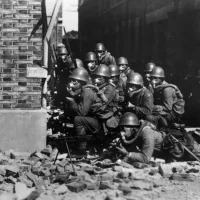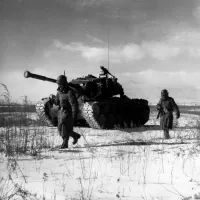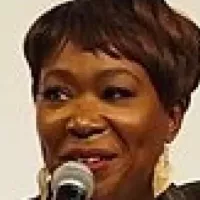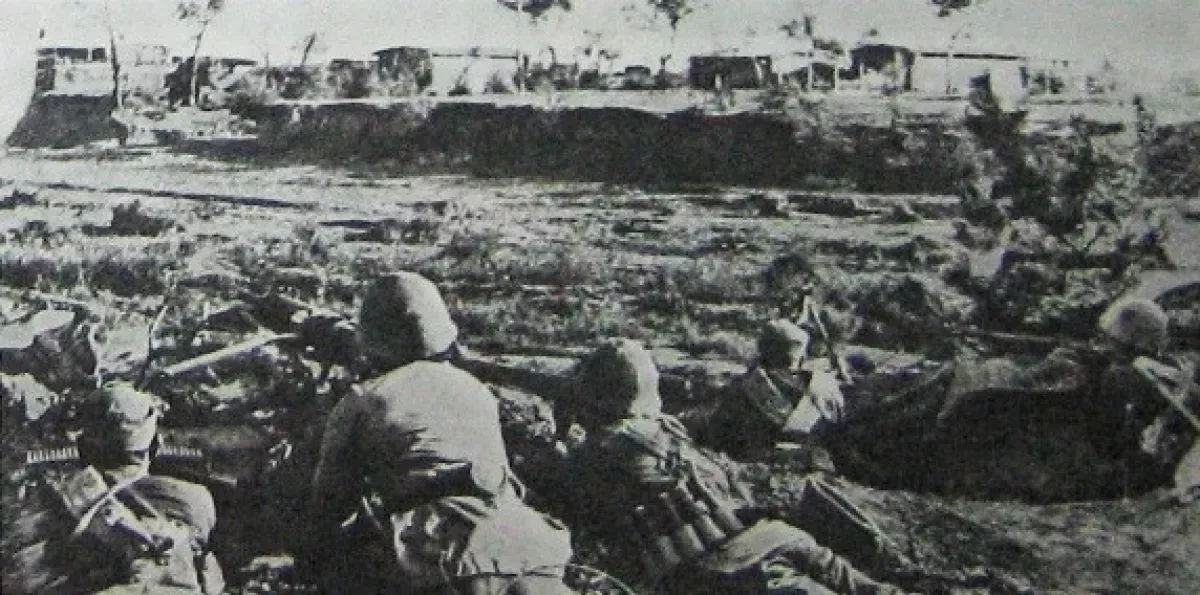The Chinese Civil War was a conflict between the Kuomintang (KMT)-led government of the Republic of China and the Chinese Communist Party (CCP). Beginning on August 1, 1927, the intermittent armed conflict concluded on December 7, 1949, with a Communist victory. This resulted in the CCP gaining total control over mainland China, leading to the establishment of the People's Republic of China and the retreat of the KMT to Taiwan.
1911: Sun Yat-sen Assumes Presidency
Following the collapse of the Qing dynasty, Sun Yat-sen assumed the presidency of the newly formed Republic of China in 1911.
1916: Power Struggle After Yuan Shikai's Death
After Yuan Shikai's death in 1916, China fell into a power struggle.
1922: CCP Membership in 1922
In 1922, the Chinese Communist Party (CCP) had a membership of 300.
1923: Kuomintang Membership in 1923
As of 1923, the Kuomintang had 50,000 members.
1923: Sun-Joffe Manifesto and Soviet Assistance
In 1923, Sun Yat-sen and Soviet representative Adolph Joffe in Shanghai pledged Soviet assistance to China's unification in the Sun–Joffe Manifesto, a declaration of cooperation among the Comintern, KMT, and the Chinese Communist Party (CCP). Comintern agent Mikhail Borodin arrived in 1923 to aid in the reorganization and consolidation of both the CCP and the KMT along the lines of the Communist Party of the Soviet Union. The CCP, which was initially a study group, and the KMT jointly formed the First United Front.
1923: Chiang Kai-shek's Military and Political Study in Moscow
In 1923, Sun Yat-sen sent Chiang Kai-shek to Moscow for military and political study, after which Chiang became the head of the Whampoa Military Academy.
1925: KMT Split and CCP Opposition
After Sun died in 1925, the KMT split into left- and right-wing movements. The CCP then began movements in opposition of the Northern Expedition, passing a resolution against it at a party meeting.
1925: CCP Membership in 1925
By 1925, the Chinese Communist Party (CCP) membership had grown to 1,500.
March 1927: KMT Second Party Meeting
In March 1927, the KMT held its second party meeting where the Soviets helped pass resolutions against the Expedition and curbing Chiang's power, leading to a clear division within the KMT.
August 1927: Beginning of Armed Conflict
In August 1927, armed conflict began between the Kuomintang-led government of the Republic of China and the Chinese Communist Party (CCP).
August 1927: Collapse of the First United Front
In August 1927, the First United Front alliance between the Kuomintang (KMT) and the Chinese Communist Party (CCP) collapsed during the Northern Expedition, leading to the Nationalists controlling most of China.
August 1927: CCP Uprising in Nanchang and Creation of the Red Army
On 1 August 1927, the CCP launched an uprising in Nanchang against the Nationalist government in Wuhan. This conflict led to the creation of the Red Army. On 4 August, the main forces of the Red Army left Nanchang and headed southwards for an assault on Guangdong. Nationalist forces quickly reoccupied Nanchang while the remaining members of the CCP in Nanchang went into hiding. A CCP meeting on 7 August confirmed the objective of the party was to seize the political power by force, but the CCP was quickly suppressed the next day by the Nationalist government in Wuhan, led by Wang Jingwei. On 14 August, Chiang Kai-shek announced his temporary retirement, as the Wuhan faction and Nanjing faction of the Kuomintang were allied once again with common goal of suppressing the CCP after the earlier split. Wang Jingwei took the leadership of KMT after Chiang.
1927: Shanghai Massacre and White Terror
In 1927, following the Shanghai massacre, the Kuomintang initiated anti-communist campaigns known as the White Terror, resulting in the deaths of an estimated 300,000 to one million people, primarily peasants. The Nationalists targeted women with short hair and unbound feet, presuming them to be radicals, and subjected them to mutilation and public display to intimidate the populace.
1927: Rivalry and Split in Revolutionary Ranks
In early 1927, the KMT–CCP rivalry led to a split in the revolutionary ranks. The CCP and the left wing of the KMT decided to move the seat of the KMT government from Guangzhou to Wuhan, where communist influence was strong. However, Chiang and Li Zongren, whose armies defeated the warlord Sun Chuanfang, moved eastward toward Jiangxi. The leftists rejected Chiang's demand to eliminate Communist influence within KMT, and Chiang denounced them for betraying Sun Yat-sen's Three Principles of the People by taking orders from the Soviet Union. According to Mao Zedong, Chiang's tolerance of the CCP in the KMT camp decreased as his power increased.
June 1928: KMT Capture of Beijing
In June 1928, the KMT captured Beijing, and soon most of eastern China was under the control of the Nanjing central government, which received international recognition as the sole legitimate government of China.
December 1930: Futian Incident
In December 1930, during the Futian incident, the communists executed 2,000 to 3,000 members of the Futian battalion after its leaders mutinied against Mao Zedong.
1930: Central Plains War
In 1930, the Central Plains War broke out as an internal conflict of the KMT, launched by Feng Yuxiang, Yan Xishan, and Wang Jingwei.
1931: Communist violence in Jiangxi–Fujian Soviet
In 1931, communist authorities in the Jiangxi–Fujian Soviet engaged in widespread violence against civilians to enforce policies and prevent defection to the KMT. This included mass executions and forced labor.
1932: Fourth Encirclement Campaign
In 1932, the fourth campaign against CCP activity began, achieving some early successes.
1933: KMT Armies Mauled in Soviet Chinese Republic
In 1933, Chiang's armies were badly mauled when they tried to penetrate into the heart of Mao's Soviet Chinese Republic.
October 1934: CCP Breaks Out of Encirclement
In October 1934, the CCP took advantage of gaps in the ring of blockhouses and broke out of the encirclement, beginning the Long March.
1934: Communist violence in Jiangxi–Fujian Soviet
In 1934, communist authorities in the Jiangxi–Fujian Soviet continued a campaign of violence against civilians to ensure compliance and prevent defection to the KMT, leading to mass graves uncovered by the KMT.
1934: Fifth Encirclement Campaign
In late 1934, Chiang launched a fifth campaign that involved the systematic encirclement of the Jiangxi Soviet region with fortified blockhouses, devised in part by newly hired Nazi advisors.
November 1935: Mao Takes Over Leadership of the Red Army
In November 1935, Mao Zedong officially took over Zhou Enlai's leading position in the Red Army, becoming the chairman of the Military Commission, marking Mao's position as the pre-eminent leader of the CCP.
December 1936: Xi'an Incident
On 12 December 1936, Zhang Xueliang and Yang Hucheng kidnapped Chiang Kai-shek and forced him into a truce with the CCP in what became known as the Xi'an Incident.
1936: Zhou Enlai Persuades Zhang Xueliang and Yang Hucheng
In 1936, Zhou Enlai persuaded Zhang Xueliang and Yang Hucheng to instigate the Xi'an Incident.
December 1940: Chiang Demands Evacuation of New Fourth Army
In December 1940, Chiang demanded that the CCP's New Fourth Army evacuate Anhui and Jiangsu Provinces due to provocation and harassment of KMT forces.
1941: Ambush of New Fourth Army and End of Second United Front
In 1941, KMT forces ambushed the New Fourth Army during their evacuation, leading to thousands of deaths and ending the Second United Front.
1941: Soviet Union warns CCP against Civil War
In 1941, the Soviet Union, allied with the CCP, sent a telegram to Mao Zedong warning that a civil war would benefit the Japanese military.
1943: Chiang Kai-shek criticizes CCP in "China's Destiny"
In 1943, Chiang Kai-shek criticized the CCP in the propaganda piece "China's Destiny", questioning their power after the war. The CCP responded by opposing Chiang's leadership and labeling his regime as fascist.
1944: Japan launches Operation Ichi-Go against KMT
In 1944, Japan launched Operation Ichi-Go, its last major offensive against the KMT, which weakened Chiang Kai-shek's forces.
October 1945: Chongqing Peace Negotiation and Double Tenth Agreement
From August 28 to October 10, 1945, Chiang Kai-shek and Mao Zedong attended the first post-war peace negotiation in Chongqing, resulting in the signing of the Double Tenth Agreement. Despite stressing peaceful reconstruction, the conference produced no concrete results, and battles continued.
November 1945: KMT forces push to Jinzhou
By November 26, 1945, Chiang Kai-shek's forces pushed as far as Jinzhou, meeting little resistance.
November 1945: KMT campaign to prevent CCP strengthening its base
On November 15, 1945, the KMT began a campaign to prevent the CCP from strengthening its base. The return of the KMT also brought widespread graft and corruption.
November 1945: Hurley resigns as American Ambassador
On November 26, 1945, American ambassador Patrick J. Hurley resigned, believing Chiang Kai-shek had violated his agreement with the Communists.
December 1945: Marshall replaces Hurley as ambassador
In December 1945, Marshall filled Hurley's former position.
1945: Weakening of the Nationalist Party
According to historian Odd Arne Westad, Chiang Kai-shek's party was weakened in the war against the Japanese.
1945: End of the Second United Front
By 1945, the Second United Front concluded as World War II ended, and the conflict between the KMT and CCP was set to resume.
1945: Communist-governed areas in China
By Spring 1945, the Communists governed 19 areas in China, inhabited by 95 million people. By Fall 1945, the Communist armies had 1.27 million men and were supported by 2.68 million militia members.
1945: Growth of Chinese Communist Party Power
By the end of the Second Sino-Japanese War in 1945, the CCP's main force grew to 1.2 million troops with an additional militia of 2 million. Their "Liberated Zone" contained 19 base areas, including one-quarter of the country's territory and one-third of its population. The Soviet Union also turned over captured Japanese weapons and supplies to the Communists.
1945: Casualties in the Chinese Civil War
From 1945 to 1949, the Communist military forces suffered 1.3 million combat casualties: 260,000 killed, 190,000 missing, and 850,000 wounded. Nationalist casualties were recorded after the war by the PRC as 5,452,700 regulars and 2,258,800 irregulars.
1945: US Support to the Nationalists
In 1945, the United States government provided economic and military support exclusively to the Nationalists.
1945: Resumption of the Civil War
In 1945, the civil war resumed between the Communists and Nationalists as Japanese defeat was imminent, with the communists gaining the upper hand in the second phase of the war.
1945: Stalin commands Malinovsky to give Mao weapons
In the winter of 1945–1946, Joseph Stalin commanded Marshal Rodion Malinovsky to give Mao Zedong most Imperial Japanese Army weapons that were captured.
January 1946: Temporary avoidance of large campaigns and full-scale confrontations
In January 1946, despite the ongoing peace negotiations, an agreement was reached to temporarily avoid large campaigns and full-scale confrontations between the CCP and Chiang's troops.
March 1946: Soviet Red Army delays withdrawal from Manchuria
In March 1946, the Soviet Red Army under Marshal Rodion Malinovsky delayed pulling out of Manchuria despite requests from Chiang, while secretly telling CCP forces to move in. Soviet diplomats also requested a joint venture of industrial development with the Nationalist Party in Manchuria on March 27.
June 1946: Full-scale war breaks out between CCP and KMT forces
On June 26, 1946, the truce fell apart and full-scale war broke out between CCP and KMT forces, initiating over three years of civil war in China.
July 1946: Chiang Kai-shek launches large-scale assault on Communist territory
On July 20, 1946, Chiang Kai-shek launched a large-scale assault on Communist territory in North China with 113 brigades, totaling 1.6 million troops, marking the resumption of the civil war.
1946: Mao Zedong pushes for radical land policies
In 1946, at the outbreak of the Chinese Civil War, Mao Zedong advocated a return to radical policies to mobilize China against the landlord class. The 7 July Directive led to the confiscation and redistribution of landlord and rich peasant property, with CCP work teams dividing the population into classes.
1946: Nationalist repression of political dissidents
In 1946, the Nationalists began arresting, torturing, and killing political dissidents through the Sino-American Cooperative Organization.
1946: Stalin commands Malinovsky to give Mao weapons
In the winter of 1945–1946, Joseph Stalin commanded Marshal Rodion Malinovsky to give Mao Zedong most Imperial Japanese Army weapons that were captured.
March 1947: KMT seizes Yan'an
In March 1947, the KMT achieved a symbolic victory by seizing Yan'an, the capital of the Yan'an Soviet. However, the Communists counterattacked soon afterwards.
June 1947: CCP troops cross the Yellow River
On June 30, 1947, CCP troops crossed the Yellow River and moved to the Dabie Mountains area, restoring and developing the Central Plain.
September 1947: Communist forces begin counterattacks
From June to September 1947, Communist forces began to counterattack in Northeastern China, North China, and East China.
October 1947: Outline Land Law intensifies land reform violence
In October 1947, the Outline Land Law intensified the land reform campaign, leading to extreme violence against those condemned as landlords, including being buried alive, dismembered, strangled, and shot.
1947: Increased US Aid to Nationalists
In 1947, the United States increased aid to the Nationalists, leading the Communists to frame the conflict as one between themselves and "US imperialists and their puppets".
April 1948: Luoyang falls to the CCP
By April 1948, the city of Luoyang fell to the CCP, cutting the KMT army off from Xi'an.
June 1948: Chiang Acknowledges Internal Disintegration
In June 1948, Chiang Kai-shek wrote in his diary: "After the fall of Kaifeng our conditions worsened and became more serious. I now realized that the main reason our nation has collapsed, time after time throughout our history, was not because of superior power used by our external enemies, but because of disintegration and rot from within."
August 1948: Start of significant Communist military campaigns
The period of August 1948 through October 1949 included the three most significant Communist military campaigns of the civil war: the Liaoshen Campaign (northeast China), Huaihai Campaign (east China), and Pingjin Campaign (Beijing-Tianjin).
September 1948: CCP captures Jinan and Shandong province
Following a fierce battle, the CCP captured Jinan and Shandong province on 24 September 1948. During this period, the Battle of Weixian took place, which was an important battle for the CCP to liberate Shandong.
September 1948: Liaoshen Campaign launched
On 12 September 1948, the Liaoshen campaign was launched and led by Lin Biao, with the main focus being Jinzhou.
November 1948: Beginning of Pingjin Campaign
The Pingjin campaign began on 21 November 1948, lasting 64 days until 31 January 1949.
1948: Increased US Aid to Nationalists
In 1948, the United States increased aid to the Nationalists, leading the Communists to frame the conflict as one between themselves and "US imperialists and their puppets".
1948: Economic Collapse in ROC Areas
In late 1948, the Gold Yuan depreciated sharply which resulted in the ROC government losing the support of the cities' middle classes.
1948: Huaihai Campaign secures east-central China for CCP
The Huaihai Campaign of late 1948 and early 1949 secured east-central China for the CCP. A large number of KMT troops deserted and changed sides in these conflicts.
January 1949: End of Pingjin Campaign
The Pingjin campaign lasted 64 days, from 21 November 1948 to 31 January 1949. The KMT's defeat in the Pingjin campaign ended its ability to be an effective fighting force on the mainland.
June 1949: ROC Declares Closure of Mainland China Ports
In June 1949, the ROC declared a closure of all mainland China ports, with its navy attempting to intercept all foreign ships from north of the Min River in Fujian to the Liao River in Liaoning. This naval activity caused severe hardship for mainland China fishermen and significantly impacted north-south trade, which depended heavily on sea lanes due to the underdeveloped railroad network.
October 1949: Mao Zedong proclaims the People's Republic of China
On 1 October 1949, Mao Zedong officially proclaimed the People's Republic of China with its capital at Beiping, renamed Beijing.
October 1949: End of significant Communist military campaigns
The period of August 1948 through October 1949 included the three most significant Communist military campaigns of the civil war: the Liaoshen Campaign (northeast China), Huaihai Campaign (east China), and Pingjin Campaign (Beijing-Tianjin).
December 1949: Chiang proclaims Taipei the temporary capital of the Republic of China
In December 1949, Chiang proclaimed Taipei the temporary capital of the Republic of China and continued to assert his government as the sole legitimate authority in China.
December 1949: Communist Victory and Control of Mainland China
In December 1949, the Chinese Communist Party's victory resulted in their total control over mainland China.
1949: Nationalist repression of political dissidents
By 1949, the Nationalists continued arresting, torturing, and killing political dissidents through the Sino-American Cooperative Organization.
1949: Casualties in the Chinese Civil War
From 1945 to 1949, the Communist military forces suffered 1.3 million combat casualties: 260,000 killed, 190,000 missing, and 850,000 wounded. Nationalist casualties were recorded after the war by the PRC as 5,452,700 regulars and 2,258,800 irregulars.
1949: US Support to the Nationalists
In 1949, Mao contended that the United States had provided US$5.9 billion to the Nationalists from 1945 to 1949 "to help Chiang Kai-shek slaughter several million Chinese".
1949: CCP captures Nanjing
In 1949, Mao rejected Stalin's call to halt the CCP from crossing the Yangtze. On April 21, the Yangtze River Crossing Campaign began and on April 23, they captured the KMT's capital, Nanjing. By late 1949, the People's Liberation Army was pursuing remnants of KMT forces southwards in southern China.
1949: Homecoming Legion's guerrilla warfare continues
In 1949, as the civil war neared its end, the Kuomintang-backed "Huanxiang Tuan" (Homecoming Legion), composed of landlords and conscripted peasants, continued its guerrilla warfare against CCP forces and purported collaborators.
1949: Huaihai Campaign secures east-central China for CCP
The Huaihai Campaign of late 1948 and early 1949 secured east-central China for the CCP. A large number of KMT troops deserted and changed sides in these conflicts.
January 1950: US Announces Non-Intervention Policy in Taiwan Strait
On January 5, 1950, US President Harry S. Truman announced the United States would not engage in any dispute involving the Taiwan Strait and would not intervene if the PRC attacked. Truman also stated the US would obey the Cairo Declaration, designating Taiwan as Chinese territory, marking a policy of non-assistance to the Nationalists.
April 1, 1950: China Supplies Military Equipment to Viet Minh
On April 1, 1950, China, like the Eastern bloc, recognized the Hanoi government and began supplying military equipment to Ho Chi Minh's Viet Minh in accordance with an agreement. This assistance played a key role in the Viet Minh's victory at the Battle of Dien Bien Phu in 1954.
April 1950: Communist conquest of Hainan Island
In April 1950, Communist amphibious operations led to the conquest of Hainan Island.
May 1950: Communist conquest of Zhoushan Island
In May 1950, Communist amphibious operations led to the conquest of Zhoushan Island off Zhejiang.
June 1950: Korean War Leads to US Intervention in Taiwan Strait
In June 1950, the onset of the Korean War led to a shift in US policy, with President Truman ordering the United States Seventh Fleet to the Taiwan Strait as part of a containment policy against potential Communist expansion.
August 1950: Communist conquest of Wanshan Islands
From May to August 1950, Communist amphibious operations led to the conquest of the Wanshan Islands off the Guangdong coast.
1950: CCP Gains Control of Mainland China
In 1950, the CCP won control of China proper and annexed Tibet. After this victory a group of KMT soldiers retreated to Burma to launch guerrilla attacks into south China during the Kuomintang Islamic Insurgency in China (1950–1958).
1951: CCP Controls Mainland China
By late 1951, the CCP controlled the entire mainland (excluding Kinmen and Matsu Islands). However, a group of approximately 3,000 KMT Central soldiers retreated to Burma and continued launching guerrilla attacks into south China during the Kuomintang Islamic Insurgency in China (1950–1958).
February 1952: UN Condemns Soviet Union for Supporting CCP
In February 1952, the UN General Assembly adopted Resolution 505, condemning the Soviet Union for violating the Sino-Soviet Treaty of Friendship and Alliance by supporting the CCP, following a complaint by the ROC.
1953: Burma Appeals to UN Regarding KMT Presence
In 1953, the Burmese government appealed to the United Nations regarding the presence of KMT remnants in Burma. Subsequently, the US began pressuring the ROC to withdraw its loyalists.
1954: Partial Withdrawal of KMT Soldiers from Burma
By the end of 1954, nearly 6,000 KMT soldiers had left Burma, and their leader Li Mi declared his army disbanded. However, thousands remained, with continued support and command from the ROC.
1954: Chinese Military Aid in Viet Minh Victory
In 1954, Chinese military aid played a key role in the Viet Minh's victory at the Battle of Dien Bien Phu. The recognition of North Vietnam by the People's Republic of China also led to the creation of an independent "State of Vietnam" in the south.
1954: Campaign to Suppress Counterrevolutionaries
In 1954, the CCP reported that during the Campaign to Suppress Counterrevolutionaries, at least 2.6 million people were arrested, 1.29 million were imprisoned, and 712,000 were executed. Those killed were mostly former Kuomintang officials, businessmen, former employees of Western companies and intellectuals.
January 1955: PRC Captures Yijiangshan Islands
On January 19, 1955, during the First Taiwan Strait Crisis, the PRC captured the Yijiangshan Islands, leading to the ROC abandoning the Dachen Islands the following month. On 24 January 1955, the United States Congress passed the Formosa Resolution authorizing the President to defend the ROC's offshore islands.
March 1955: End of First Taiwan Strait Crisis
In March 1955, the First Taiwan Straits crisis ended when the PLA ceased its bombardment. The crisis concluded during the Bandung conference.
August 1958: Second Taiwan Strait Crisis Begins
On August 23, 1958, the Second Taiwan Strait Crisis began with air and naval engagements between PRC and ROC forces, leading to intense artillery bombardment of Kinmen by the PRC and Xiamen by the ROC. PLA patrol boats blockaded the islands from ROC supply ships.
1958: Kuomintang Islamic Insurgency in China Continues
In 1958, the Kuomintang Islamic Insurgency in China, which had started in 1950, continued as KMT forces that had retreated to Burma after the Communist victory continued to launch guerrilla attacks into south China.
October 1971: PRC Admitted to United Nations, ROC Expelled
On October 25, 1971, the United Nations General Assembly admitted the PRC and expelled the ROC, which had been a founding member of the United Nations and was one of the five permanent members of the Security Council. Recognition for the People's Republic of China soon followed from most other member nations, including the United States.
1979: Cessation of Open Conflict
In 1979, after the Second Taiwan Strait Crisis, both sides of the conflict tacitly ceased to engage in open conflict, though no armistice or peace treaty was ever signed.
1984: PRC and ROC Begin De-escalation
By 1984, PRC and ROC began to de-escalate their hostilities through diplomatic relations with each other, and cross-straits trade and investment has been growing ever since.
May 1991: ROC Renounces Temporary Provisions
In May 1991, the Temporary Provisions Effective During the Period of Communist Rebellion was renounced by the new ROC president Lee Teng-hui, thus ending the chances of the Kuomintang's quest to retake the mainland.
1991: ROC Officially Declares End to State of War
In 1991, the state of war was officially declared over by the ROC. Despite the end of the hostilities, the two sides have never signed any agreement or treaty to officially end the war.
1995: PRC Responds to Taiwanese President's Visit to US with Military Exercises
In 1995, the PRC responded to Taiwanese President Lee Teng-hui's visit to the United States, and the U.S. recognition of Lee as a representative of Taiwan, with military exercises intended to deter Taiwanese voters from supporting Lee in the 1996 election. Two U.S. aircraft carriers were deployed during the crisis.
1996: Lee Wins Election; De-escalation Follows
In 1996, Taiwanese President Lee Teng-hui won the election, and de-escalation followed the military exercises.
July 1999: Lee Announces Special Diplomatic Relationship
In July 1999, ROC president Lee Teng-hui announced a "special diplomatic relationship", resulting in fury from China. Military drills were eventually stopped due to the 921 earthquakes.
2000: Chen Shui-bian Elected President of Taiwan
In 2000, Democratic Progressive Party candidate Chen Shui-bian was elected, marking the first time a party other than the KMT gained the presidency in Taiwan. The new president did not share the Chinese nationalist ideology of the KMT and CCP, which led to tension between the two sides.
2005: Pan-Blue Visit
In 2005, despite tensions from the election of Chen Shui-bian in 2000, trade and other ties such as the 2005 Pan-Blue visit continued to increase between Taiwan and the mainland.
2008: Ma Ying-jeou Elected President
In 2008, with the election of pro-mainland President Ma Ying-jeou, significant warming of relations resumed between Taipei and Beijing, with high-level exchanges between the semi-official diplomatic organizations of both states such as the Chen-Chiang summit series.
April 2022: Pelosi's Taiwan Visit Delayed
In April 2022, US Speaker of the House Nancy Pelosi's intended visit to Taiwan was delayed due to COVID-19.
August 2022: Pelosi's Visit Triggers PRC Military Exercises
In August 2022, US Speaker of the House Nancy Pelosi's visit to Taiwan triggered PRC military exercises across the Taiwan Strait. As a result, the PLA announced four days of unprecedented military live-fire drills in six zones that encircle the island on the busiest international waterways and aviation routes.
Mentioned in this timeline

Nancy Pelosi is a prominent American politician notably serving as...
The Union of Soviet Socialist Republics USSR existed from to...

The Second Sino-Japanese War fought between China and Japan from...
China officially the People's Republic of China PRC is an...

The Korean War - was a conflict between North Korea...
Japan is an East Asian island country situated in the...
Trending
4 months ago Fenerbahçe seeks advantage against 'Flying Dutchman,' Azeri TV cheers, stands with Palestine.
8 months ago Bucknell Sued After Hazing Allegedly Leads to Freshman Football Player's Death
29 days ago OpenAI's GPT-5.1: Smarter, Conversational ChatGPT with New Personalities and Improved Speed.

4 months ago Ranger Suárez's Future: Predictions of Departure and Potential $115 Million Contract.
6 months ago Dodgers Defeat Padres: Smith's Walk-Off Homer Secures Victory in Historic Game

Joy-Ann Reid is an American political commentator and television host known for her work on MSNBC She is best known...
Popular

Candace Owens is an American conservative political commentator and author...

Ilhan Omar is an American politician currently serving as the...
Matt and Ross Duffer known as the Duffer Brothers are...

XXXTentacion born Jahseh Dwayne Ricardo Onfroy was a controversial yet...

Tom Cotton is an American politician and Army veteran currently...
The Kennedy Center Honors are annual awards recognizing individuals and...
